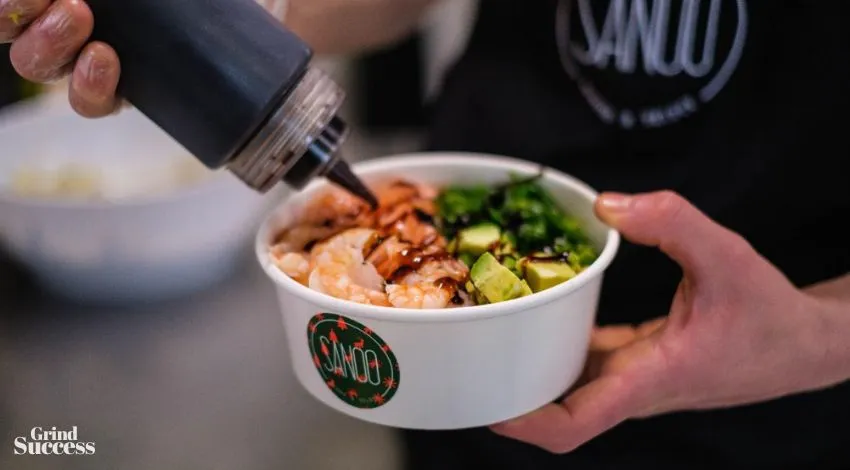Culinary Entrepreneurship: A Comprehensive Guide to Launching Your Food Business

The world of commerce and trade is full of different ventures. However, few industries can match the food market’s universal appeal and consistent demand.
From the humblest street vendors to the grandest fine-dining establishments, food is a fundamental aspect of human existence—intertwining with culture, tradition, and pleasure. The Food industry encompasses many businesses, each contributing to a multi-trillion-dollar global market.
More individuals have become interested in pursuing the food-related idea. However, it’s become increasingly difficult to compete. As such, there are certain things you need to know if you’re interested in being an entrepreneur in this industry.
Whether you’re an industry veteran or an up-and-coming player in the market, here is everything you need to know to grow your business in the food industry.
Table of Contents
Developing a Solid Business Plan
All good ideas begin with a plan, and starting a food business is not any different. Understanding the essential components of a business plan can ensure your venture’s long-term success.
1. Conduct market analysis
Before diving into the culinary world, conducting a thorough market analysis is crucial. This research will help you identify competitors and understand potential customers’ preferences, ultimately letting your grasp current market trends.
With this knowledge, you can shape your culinary offerings and tailor your marketing strategies to stand out in the dynamic landscape.
2. Identify your niche and target market
Defining your niche is akin to creating a signature dish that separates your food business. Whether it’s a particular cuisine, a fusion of flavors, or a special focus on dietary preferences, discovering your unique selling point will give your venture a distinctive edge.
Once you’ve defined your niche, target your marketing efforts to cater to the tastes and preferences of your ideal customers.
3. Create a unique value proposition
Your food business’s brand is the heart and soul of your venture. As such, you need to craft a unique value proposition (USP) that reflects what makes your business exceptional. This proposition will add flavor to your brand’s identity and become the guiding force behind your marketing activities.
Make your branding stand out further by making it consistent across all aspects, from your logo design to your social media content. This step is vital to a USP, helping you build customer trust and recognition.
4. Set realistic goals
Ambition is commendable, but setting realistic, measurable goals is essential. Break down your long-term vision into smaller, achievable milestones. As you achieve these milestones, take the time to celebrate each success by acknowledging the hard work and dedication that got you there.
Also, remember that progress may not always be linear. Challenges are inevitable, but perseverance is the key.
So, stay committed to your goals and be ready to adjust your strategies when necessary as you monitor your growth and progress. This way, you’ll create the perfect recipe for your food business’s triumphant success.
5. Craft effective marketing strategies
In the fiercely competitive food industry, the success of your mouthwatering dishes hinges on effective marketing strategies. Leveraging the power of social media becomes paramount as you seek to engage directly with your audience.
Platforms like Instagram and Facebook offer the perfect stage to tantalize taste buds with drool-worthy images and captivating content. However, a successful marketing approach goes beyond mere promotions. It delves into the storytelling behind your brand, creating a compelling narrative that resonates with your customers.
Nurturing a community of food enthusiasts lets your marketing ` and your business beyond a transactional exchange.
6. Manage costs effectively
Analyzing expenses with a discerning eye enables you to identify opportunities for efficiency without compromising the essence of your dishes. Adopting a data-driven approach is one of the best tips to do so.
Data analytics and financial reporting tools provide valuable insights into spending patterns, revenue streams, and cost-saving opportunities. You can make strategic adjustments that yield tangible results with a data-driven approach. It allows you to base your decisions on empirical evidence and informed analysis.
7. Stay flexible and adaptable
In the ever-changing landscape of the food industry, remaining flexible and adaptable is a matter of survival and success. Customer preferences, dietary trends, and market demands can shift rapidly—and businesses that fail to adjust may risk falling behind.
So, actively seek customer feedback. Doing so can help you gain invaluable insights into their needs and expectations. Use this information to make data-driven decisions when fine-tuning your menu or introducing new offerings to cater to evolving tastes.
Furthermore, staying attuned to emerging industry trends is vital for maintaining relevance and competitiveness. Keeping a pulse on the latest culinary innovations and health-conscious options allows you to seize new opportunities and appeal to a broader audience.
Whether it’s integrating plant-based alternatives or incorporating eco-friendly practices, embracing change is an excellent way to attract a diverse and loyal customer base.
Navigating Legal and Regulatory Requirements
A food business isn’t just about the artistry of creating delectable dishes. It also entails compliance with various laws and safety standards. Approach this gastronomic adventure confidently by knowing the following regulatory requirements and legalities in the food industry.
1. Licenses and permits
Acquiring the necessary licenses and permits is fundamental to legitimizing your food business. You may need permits from local health departments, business licenses from municipal authorities, and specific zoning approvals.
However, these documents will depend on your location and the nature of your culinary offerings. Ensuring all legal documentation is in place demonstrates your commitment to compliance and protects your business from potential penalties or shutdowns.
2. Health and safety regulations
Health and safety regulations take center stage in the food industry. Prioritizing food safety is non-negotiable, as it directly impacts the well-being of your customers.
You must take every precaution to prevent foodborne illnesses and maintain impeccable standards of cleanliness. For instance, consider drafting a policy or protocol on maintaining kitchen hygiene. You can also provide staff training on safe food handling practices.
Regular health inspections and compliance with sanitation guidelines are essential to building trust with your patrons and safeguarding your reputation.
3. Compliance with food standards
Compliance with food standards guarantees the integrity and quality of your culinary offerings. From sourcing ingredients to the preparation process, adhering to established food standards helps you deliver consistent and exceptional dishes that resonate with your patrons.
So, familiarize yourself with industry-specific standards and regulations. This way, you can ensure your food business operates within ethical and legal boundaries.
4. Proper food handling, storage, and labeling
Proper food handling, storage, and labeling are the invisible guardians of your culinary creations. Paying meticulous attention to these aspects safeguards against cross-contamination and other foodborne illnesses or accidents.
Implement effective food storage practices, like maintaining proper temperature controls and deploying the first-in, first-out (FIFO) method. This way, you can have organized storage while minimizing waste. Clear, accurate labeling is also crucial. It provides vital information on allergens, nutritional content, and expiration dates.
Prioritizing these elements demonstrates your commitment to transparency and customer well-being.
Leveraging Social Media for Food Marketing
Mastering the art of food marketing through social media is an indispensable skill for any aspiring food business. Harnessing the power of these online platforms opens up a world of opportunities to engage with a vast audience and cultivate a loyal customer base.
With that, here are a few social media platforms you can use to help promote and grow your culinary venture.
1) Instagram
With its visually captivating format, Instagram has become a primary platform for showcasing culinary creations. This platform lets you entice followers and build a visually enticing brand presence. Take behind-the-scenes glimpses into your kitchen. You can show your followers how you make your food.
2) Facebook
Known for its interactive community, Facebook enables food businesses to engage with their audience through polls, Q&A sessions, and live videos. By fostering meaningful interactions, you can create a sense of connection and loyalty among your followers.
3) Twitter
Twitter’s fast-paced nature makes it ideal for sharing quick updates and timely promotions. Engaging in real-time conversations with your audience and participating in food-related trends can help you build a dynamic online presence. Ultimately, this platform can ensure your food business stays relevant.
4) Pinterest
Add a dash of inspiration to your social media recipe by leveraging the visual wonderland of Pinterest. This platform lets you create captivating boards full of luscious food photography, delectable recipes, and kitchen tips.
With trendy food trends and DIY cooking hacks, you can connect with a vast community of culinary enthusiasts eager to explore your creations on this social networking site.
5) YouTube
Embrace the immersive storytelling power of video through YouTube, a platform where your culinary artistry can shine. Here, you can share engaging cooking tutorials and informative chef interviews. Building a YouTube presence enhances your brand authority and opens opportunities for partnerships and sponsorships.
6) TikTok
Spice up your social media strategy with some playfulness on TikTok. This vibrant platform thrives on short-form, entertaining videos. Showcase your culinary expertise with quick recipes, food challenges, and engaging kitchen hacks that captivate the attention of Gen Z and Millennial audiences.
7 Effective Tips to Utilize Social Media in Marketing a Food Business
Knowing how to use social media for your marketing efforts properly is a must to ensure your food business’s success. Consider the following tips to help your socials boost your marketing strategies.
1. Craft irresistible visual stories
Set the culinary stage on social media with captivating visual stories that awaken the foodie soul. From the sizzle of a perfectly seared steak to the velvety swirls of artisan gelato, let your food photography and videos spark an insatiable craving in your audience.
Peel back the curtains and take your audience behind the kitchen doors to witness the culinary magic. Share heartwarming anecdotes that unveil the passion and dedication infused into every dish.
2. Connect with and nurture a loyal following
Social media isn’t just about posting. It’s about savoring the conversation with your food-loving customers.
Engage authentically with your audience, responding to their comments and messages with genuine warmth. Host live sessions where you answer their culinary queries and share tips that elevate their home-cooking game.
3. Ride the waves of food trends and seasonal delights
Capitalize on popular food trends by riding the currents of viral recipes and innovative flavors. Dive into the seasonal bounty, crafting menus that embrace nature’s culinary gifts.
For instance, you can add a fall edition menu featuring a pumpkin spice latte. Whatever item you add, ride the tides of seasonal delights and create excitement around your ever-changing culinary offerings.
4. Elevate your reach through influencers and partnerships
Utilize influencer marketing to elevate your food business to new heights. Collaborate with renowned chefs, food bloggers, and local tastemakers who share your passion for exceptional cuisine.
Together, orchestrate gastronomic experiences that tantalize the taste buds of your combined audience to expand your reach and increase engagement.
5. Hold contests and giveaways
Spice up your social media presence by offering freebies for winning events or contests. Organize recipe challenges that inspire culinary creativity among your followers. For example, you can offer winners giveaways featuring chef’s table experiences or gourmet gift boxes filled with artisanal delights.
Moreover, you may also consider offering exclusive sneak peeks and limited-time promotions to create a sense of anticipation that leaves them craving more.
6. Educate and inspire with culinary tips and DIY tutorials
Share expert tips and DIY tutorials that empower them to create gastronomic masterpieces. Teach them the art of plating like a pro. Offer advice for mastering culinary techniques and guide them through mouthwatering recipe variations.
Helping them level up their cooking skills can make your customers more willing to dine in your restaurant.
7. Celebrate your customers with user-generated content
Give back to your community by commending their work through user-generated content. Encourage followers to share their dining experiences, recipe triumphs, and cherished food memories using your branded hashtags.
Showcase your love and loyalty by featuring loyal customers in your posts in your social media feeds and stories. This heartfelt thank-you can transform customers into valued brand ambassadors.
Building Relationships with Suppliers and Partners
Strong relationships with local producers and distributors are vital to a successful food business. Here are several key reasons why these connections are essential.
1. Access to fresh, quality ingredients
Building relationships with local farmers allows you to source the freshest and highest-quality ingredients for your culinary creations.
Forming these working relationships lets you quickly obtain produce, meats, and other essential ingredients directly from local sources. This way, you can infuse your dishes with flavors and textures unparalleled in freshness and taste.
Ultimately, this commitment to quality can distinguish your food business and keep customers coming back for more.
2. Support for local communities and sustainability
Collaborating with local farmers, producers, and distributors fosters a sense of community support and sustainability. By purchasing from local sources, you contribute to the local economy. In turn, you help bolster the livelihoods of these producers and their families.
Promoting sustainable agricultural practices and reducing food miles also minimizes your carbon footprint, positively impacting the environment.
3. Allows for flexibility and customization
Establishing close relationships with local suppliers offers flexibility and customization opportunities. You can work directly with farmers to grow ingredients tailored to your culinary needs or adapt to seasonal availability.
This adaptability allows you to create unique, ever-changing menus that align with your culinary vision and cater to your customer’s preferences.
4. Trust and Reliability
As you develop a mutual understanding of needs and requirements, you can count on a steady and consistent supply of ingredients. Having a community of producers can help you deliver top-notch dishes consistently without compromising quality or availability.
5. Storytelling and Authenticity
Collaborating with local suppliers adds depth and authenticity to your brand’s narrative. You can share the stories of the farmers and producers who contribute to your culinary creations. Doing so connects your customers with the people and passion behind their meals.
This storytelling aspect adds a personal touch to your food business, making it more relatable and endearing to your audience.
6. Competitive advantage
Forming local partnerships can be a significant differentiator in the competitive food industry. This trend may stem from increased customers valuing transparency and ethical sourcing in their dining choices.
As such, showcasing your commitment to local ingredients and community support lets you create a USP that sets you apart from larger, more impersonal food chains.
Delivering Exceptional Customer Experience
Beyond serving delectable dishes, how you engage with customers and curate their overall dining journey profoundly impacts their perception of your brand. Here’s why focusing on customer service matters and essential tips to excel in these areas.
1. Foster customer loyalty
Delivering great customer service fosters a sense of loyalty and connection with your patrons. Satisfied customers are more likely to return to your establishment, becoming repeat customers who contribute significantly to your business’s revenue and stability.
2. Gain referrals
A memorable dining experience encourages customers to share their positive encounters within their circles. Word-of-mouth referrals are incredibly powerful and can bring in new customers eager to experience your food business’s excellence.
3. Boost brand credibility
People trust and gravitate towards establishments known for exceptional service. With consistent, top-notch customer service, you can build a strong brand reputation and enhance your business’s credibility within the community. In effect, you can increase your store’s footfall and positive perceptions in the market.
4. Online Reviews and Social Media Presence
Customer reviews and social media presence significantly influence consumer choices in the digital age. Providing stellar customer service generates positive online reviews and enthusiastic social media posts, which can attract a broader audience to your food business.
5. Adapting to Customer Preferences
Engaging with customers and understanding their preferences enables you to adapt your menu and offerings accordingly. Tailoring your culinary offerings to meet customer demands ensures that your business remains relevant and responsive to changing tastes.
Tips to Boost Customer Service
(1) Menu Innovation
Keep your menu exciting by offering seasonal specials highlighting the best produce available. Incorporate innovative dishes that reflect current food trends and customer preferences. A diverse and dynamic menu entices customers to return for new culinary experiences.
(2) Adjust pricing according to value
Set your pricing strategically to reflect the value of your dishes. Consider factors such as ingredient quality, portion sizes, and presentation. Strike a balance between maintaining profitability and providing customers with reasonable pricing that meets their expectations.
(3) Accommodating Dietary Needs
Stay inclusivity by offering options for various dietary restrictions and preferences. Include vegetarian, vegan, gluten-free, and other allergy-friendly choices. Communicate the availability of these options, making it easier for customers to enjoy a personalized dining experience.
Creating the Perfect Recipe for Success
The key to a thriving food business lies in a meticulously crafted plan and a willingness to learn and adapt. It may seem easy from an outsider’s perspective. However, had to work their way up in one of the most competitive niches in the world.
Fortunately, with this guide and a healthy blend of passion, dedication, and creativity, your food business can leave.
This post was proofread by Grammarly. Try it – It’s Free!
Millions trust Grammarly’s free writing app to make their online writing clear and effective. Getting started is simple
Email, SMS, and more — Klaviyo brings your marketing all together, fueling growth without burning through time and resources.
Deliver more relevant email and text messages — powered by your data. Klaviyo helps you turn one-time buyers into repeat customers with all the power of an enterprise solution and none of the complexity.






